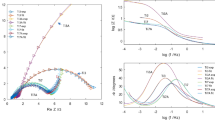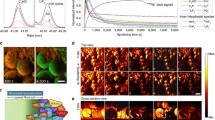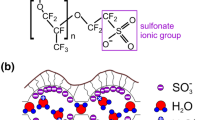Abstract
Experimental capacities and mass changes are recorded using an electrochemical quartz crystal microbalance during the first nine charge and discharge cycles of nickel hydroxide thin films cycled in 3.0 weight percent (wt%) potassium hydroxide electrolyte. For the first time, the film capacities have been corrected for the oxygen evolution side reaction, and the data used as input into a point defect-containing structural model to track the changes that occur during short-term cycling. Variations in capacity and mass during formation and charge/discharge cycling are related to changes in the point defect parameters, thus providing a structural origin for the unique experimental variations observed here and often reported in the literature, but previously unexplained. Proton-, potassium-, and water-content vary in the active material during charge/discharge cycling. The observed capacity loss, or “capacity fade,” is explained by incomplete incorporation of potassium ions in (or near) the nickel vacancy during charge, as additional protons are then allowed to occupy the vacant lattice site. The increase in water content during reduction parallels the expansion of the electrode that is well known during cycling. This result confirms the origin of the swelling phenomenon as being caused by water incorporation. The model and methodology developed in this paper can be used to correlate electrochemical signatures with material chemical structure.











Similar content being viewed by others
Notes
These four end-member materials have the same crystal structure. This structure is different from those proposed for α-Ni (OH)2 and β-Ni (OH)2. Coefficients, 2s and 3s, have been added to the traditional β, α, and γ designations of the “phases” to more clearly differentiate the unique materials, yet retain the connection to the older literature designations and Eq. 1 . Also the β forms are unambiguously defined.
Abbreviations
- E :
-
electrode potential, V
- F :
-
Faraday’s constant, 96487 C/eq.
- I :
-
applied current, A
- i o,ox :
-
exchange current for the oxygen evolution reaction, A
- i ox :
-
current expended for oxygen evolution, A
- m :
-
mass of the film, g
- M :
-
molecular weight of the film, g/mole Ni
- n :
-
the average proton occupancy of a nickel vacancy
- Ox :
-
oxidation state
- Q :
-
capacity per unit mass of film, C/g
- R :
-
universal gas constant, 8.314 J/mol K
- T :
-
temperature, K
- t :
-
time, s
- U ref,ox :
-
standard potential of the oxygen evolution reaction, V
- V Ni :
-
a vacant nickel lattice site
- x :
-
moles of vacancies per mole of lattice sites
- X w :
-
moles of water per mole of lattice sites
- y :
-
moles of vacancies occupied by potassium ions per mole of lattice sites
- z :
-
moles of exchangeable protons on interlamellar H+ sites (0≤z≤1)
- αa :
-
anodic transfer coefficient
- Δ:
-
change in variable
- ε:
-
efficiency of the nickel reaction
- λ1 :
-
moles of OH− ions per mole Ni
- λ2 :
-
moles of K+ ions per mole Ni
- λ3 :
-
moles of water per mole Ni
- λ4 :
-
number of electrons per mole Ni
- 1:
-
discharged state, nickel hydroxide
- 2:
-
charged state, oxyhydroxide
- 0:
-
as-deposited film
References
McBreen J (Ed) (1990) The nickel oxide electrode. Plenum, New York
Delichere P, Joiret S, Hugot-le Goff A, Bange K, Hetz B (1988) J Electrochem Soc 135:1856
Carpenter MK, Conell RS, Corrigan DA (1987) Solar Energy Mater 16:333
Gross S (1977), Review of electrochemical impregnation of nickel cadmium cells. Jet Propulsion Laboratory, Pasadena, Calif.
Barnard R, Randall CF, Tye FL (1980) J Appl Electrochem 10:109
Barnard R, Randall CF, Tye FL (1981) J Appl Electrochem 11:517
Kim M, Hwang T, Kim K (1997) J Electrochem Soc 144:1537
Kim M, Kim K (1998) J Electrochem Soc 145:507
Timmerman P, Ratnakumar BV, Di Stefano S (1996) In: Bennet PD, Gross S (Eds) Aqueous batteries, PV 96-16, p 130. The Electrochemical Society Proceedings Series, Pennington, NJ
Bode H, Dehmelt K, Witte J (1969), Z anorg Chem 366:1
Cornilsen BC, Karjala PJ, Loyselle PL (1988) J Power Sources 22:351
Cornilsen BC, Shan X, Loyselle PL (1990) J Power Sources 29:453
Cheek GT, O’Grady WE (1997) J Electroanal Chem 421:173
Bernard P, Gabrielli C, Keddam M, Takenouti H, Leonardi J, Blanchard P (1991) Electrochim Acta 36:743
Mo Y, Hwang E, Scherson DA (1996) J Electrochem Soc 143:37
Cordoba-Torresi SI, Gabrielli C, Hugot-Le Goff A, Torresi R (1991) J Electrochem Soc 138:1548
Haring P, Kotz R (1995) J Electroanal Chem 385:273
Kowal A, Niewiara R, Peronczyk B, Haber J (1996) Langmuir 12:2332
Kalu EE, Srinivasan V, Nwaoga T, Weidner JW (1999) In: Halpert G, Gopikanth ML, Abraham KM, Cieslak WR, Adams WA (Eds) Selected battery topics, PV 98-15, p 639. The Electrochemical Society Proceedings Series, Pennington, NJ
Streinz CC, Hartman AP, Motupally S, Weidner JW (1995) J Electrochem Soc 142:1084
Barnard R, Randell CF, Tye FL (1981) J Appl Electrochem 11:517
Corrigan DA, Knight SL (1989) J Electrochem Soc 136:613
Loyselle PL, Karjala PJ, Cornilsen BC (1986) In: Selman RJ, Maru HC (Eds) Electrochemical and thermal modeling of battery, fuel cell and photoenergy conversion systems, PV 86-12, p 114. The Electrochemical Society Proceedings Series, Pennington, NJ
Streinz CC, Motupally S, Weidner JW (1995) J Electrochem Soc 143:4051
Srinivasan V, Weidner JW, Newman J (2001) J Electrochem Soc 148:A969
Bode H, Dehmelt K, Witte J (1966) Electrochim Acta 11:1079
Barnard R, Randall CF (1982) J Appl Electrochem 12:27
Ruetschi P (1984) J Elelctrochem Soc 131:2737
Acknowledgements
The authors gratefully acknowledge the financial support from the Office of Research and Development of the United States Central Intelligence Agency and the US Department of Energy under Cooperative Agreement No. DE-FCO2–91ER75666.
Author information
Authors and Affiliations
Corresponding author
Rights and permissions
About this article
Cite this article
Srinivasan, V., Cornilsen, B.C. & Weidner, J.W. A nonstoichiometric structural model to characterize changes in the nickel hydroxide electrode during cycling. J Solid State Electrochem 9, 61–76 (2005). https://doi.org/10.1007/s10008-004-0525-x
Received:
Accepted:
Published:
Issue Date:
DOI: https://doi.org/10.1007/s10008-004-0525-x




